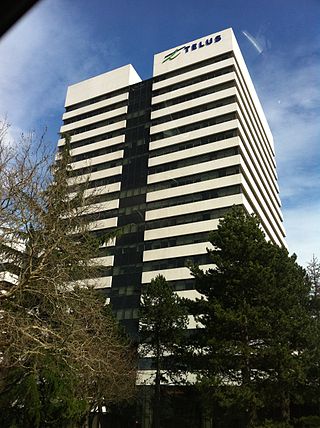
The Canadian Radio-television and Telecommunications Commission is a public organization in Canada with mandate as a regulatory agency for broadcasting and telecommunications. It was created in 1976 when it took over responsibility for regulating telecommunication carriers. Prior to 1976, it was known as the Canadian Radio and Television Commission, which was established in 1968 by the Parliament of Canada to replace the Board of Broadcast Governors. Its headquarters is located in the Central Building of Les Terrasses de la Chaudière in Gatineau, Quebec.

GTE Corporation, formerly General Telephone & Electronics Corporation (1955–1982), was the largest independent telephone company in the United States during the days of the Bell System. The company operated from 1926, with roots tracing further back than that, until 2000, when it was acquired by Bell Atlantic; the combined company took the name Verizon.

Telus Communications Inc. (TCI) is the wholly owned principal subsidiary of Telus Corporation, a Canadian national telecommunications company that provides a wide range of telecommunications products and services including internet access, voice, entertainment, healthcare, video, smart home automation and IPTV television. The company is based in the Vancouver, British Columbia, area; it was originally based in Edmonton, Alberta, before its merger with BC Tel in 1999. Telus' wireless division, Telus Mobility, offers UMTS, and LTE-based mobile phone networks. Telus is the incumbent local exchange carrier in British Columbia and Alberta. Telus' primary competitors include Shaw Communications. It also competes in the mobile sector with Shaw Communications, Rogers Communications and Bell Canada. Telus is a member of the British Columbia Technology Industry Association.

Bell Canada is a Canadian telecommunications company headquartered at 1 Carrefour Alexander-Graham-Bell in the borough of Verdun in Montreal, Quebec, Canada. It is an ILEC in the provinces of Ontario and Quebec; as such, it was a founding member of the Stentor Alliance. It is also a CLEC for enterprise customers in the western provinces.

Bell Mobility Inc. is a Canadian wireless network operator and the division of Bell Canada which offers wireless services across Canada. It operates networks using LTE and HSPA+ on its mainstream networks. Bell Mobility is the third-largest wireless carrier in Canada, with 10.1 million subscribers as of Q3 2020.
Automatic Electric Company was an American telephone equipment supplier primarily for independent telephone companies in North America, but also had a worldwide presence. With its line of automatic telephone exchanges, it was also a long-term supplier of switching equipment to the Bell System, starting in 1919. The company was the largest manufacturing unit of the Automatic Electric Group. In 1955, the company was acquired by General Telephone and Electronics (GT&E). After numerous reorganization within GTE, the companies assets it came under the umbrella of Lucent in the 1990s, and subsequently part of Nokia.
An incumbent local exchange carrier (ILEC) is a local telephone company which held the regional monopoly on landline service before the market was opened to competitive local exchange carriers, or the corporate successor of such a firm.
Bell MTS Inc. is a subsidiary of BCE Inc. that operates telecommunications services in Manitoba.

British Columbia Telephone Company and later BC Tel was the legal operating name for the telephone company operating throughout the province of British Columbia, Canada. For most of its history, BC Tel served as one of several regional monopolies in Canada. In 1985 the Canadian Radio-Television and Telecommunications Commission (CRTC) ruled to once again allow competition in long-distance telephone service. In 1998, BC Tel merged with Telus to become the second largest telecommunications company in Canada.
Saskatchewan Telecommunications Holding Corporation, operating as SaskTel, is a Canadian crown-owned telecommunications firm based in the province of Saskatchewan. Owned by the provincial government, it provides wireline and wireless communications services, including landline telephone, mobile networks, broadband internet, IPTV, and security services. Through a subsidiary, SaskTel International, the company has also worked on telecom infrastructure projects in countries such as Argentina and the Bahamas, as well as being the lead implementation company for the communication and control systems of the Channel Tunnel between England and France.

Allstream is a business communications provider based in Mississauga, Ontario, Canada, that provides Internet Protocol (IP) connectivity, managed IP services, unified communications and voice services to its customers in the United States and Canada.
The Stentor Alliance was a formal alliance of Canada's major telecommunications companies, specifically its incumbent local exchange carriers. It derives its name from the Greek mythological figure Stentor.

Canada ranks as the 21st in the world for Internet usage with 31.77 million users as of July 2016 (est), making up 89.8% of the population. According to Harvard researchers, Canada has some of the lowest internet standards among OECD countries, as a result of high costs and slow internet speeds.
Iristel is a Canadian provider of telecommunication services that is a competitive local exchange carrier (CLEC). The company was founded in 1999 and is headquartered in Markham, Ontario.

Freedom Mobile Inc. is a Canadian wireless telecommunications provider owned by Quebecor. It has 6% market share of the Canadian wireless market, mostly in urban areas of Ontario, British Columbia and Alberta. Freedom Mobile is the fourth-largest wireless carrier in Canada, with 2,290,497 subscribers as of November 30, 2022.
VMedia Inc. is a Canadian telecommunications company and broadcast distribution provider.

A telephone exchange, telephone switch, or central office is a telecommunications system used in the public switched telephone network (PSTN) or in large enterprises. It interconnects telephone subscriber lines or virtual circuits of digital systems to establish telephone calls between subscribers.
In conventional landline telephony, a non-dialable toll point or toll station was a lone station or line serving a rural subscriber many miles from the nearest central office. As it had no home telephone exchange and therefore no local calling area, no customer could dial its number; all connections to it had to be obtained manually by the long distance operator.

Xplore Inc. is a Woodstock, New Brunswick-based rural internet service provider. It is the largest rural focused broadband service provider in Canada.











